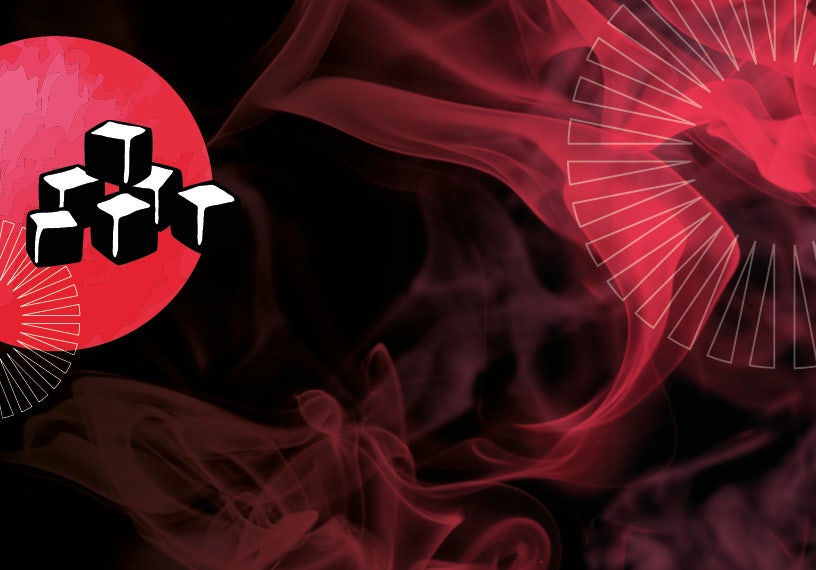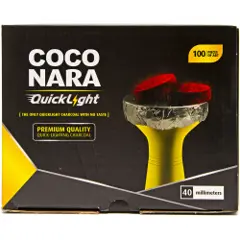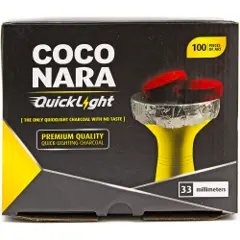Quick Lighting
LEARN MORE
Hookah users looking for a hookah charcoal option that's easy to light and starts up in no time flat need look no further than our collection of quick-lighting hookah coals. With varying recipes using ingredients like wood and coconut shells, each piece of charcoal is coated in a chemical accelerant that self-starts with the touch of a flame. Quick-light coals are convenient, easy-to-use hookah charcoal that you don't need any special equipment to light. Using quick-light hookah coals lets hookah smokers enjoy their shisha anywhere.
The main types of coal people use for their shisha include quick-light hookah coals and natural coals. Common materials used to make hookah coal briquettes include wood from fruit trees, sawdust, rice husks, coconut shells, and coconut husks. Like natural coals, quick-lighting coals feature organic materials.
A chemical accelerant is applied to the outside of quick-lighting hookah coals. The chemical accelerant makes it easy to light each quick-light coal quickly with nothing but an open flame. You can use a lighter, candle lighter, or torch to ignite quick-light hookah coals. You can also use an electric burner to start your quick-light coals. Natural coals, such as wood or coconut coals, can only be lit on a burner.
All products have pluses and minuses. Determining whether you should choose quick-light hookah coals or natural hookah coals is easier if you understand the pros and cons.
Quick-light charcoal is very convenient because you have more options for starting the coal. As its name implies, starting these coals is fast and easy. When you're ready for a hookah session, you may not want to invest the time it takes for natural coals to light.
The main drawback of quick-light charcoal centers on flavor. Most manufacturers use an accelerant such as benzene or sulfur. These accelerants get in your hookah smoke and can affect the flavor of your shisha. Natural coals often provide a cleaner, more accurate flavor profile to your smoke session. Natural coals also tend to burn longer and more evenly than quick-lighting coals, enabling you to enjoy longer smoke sessions.
You need a heat management device to light your hookah coals. The type of device you need depends on whether you're using quick-lighting coals or natural coals. You'll need a pair of metal tongs to light either type of coal. The metal tongs enable you to hold the coals without burning your hands. You can also use metal tongs to flip the coals if you're lighting them on a burner.
A candle lighter or torch will start quick-light hookah coals. Candle lighters are easy to access because you can pick them up in gas stations, grocery stores, or supermarkets. You can also use a grill lighter if you already have one. One of the advantages of a grill lighter is the longer stem, enabling you to keep your hand away from the flame. These lighters can also be easier to start, whereas cigarette lighters have a flint wheel. Some people find it hard to start a flint wheel.
You can light both natural and quick-lighting hookah coals on the burner of an electric stove. You can invest in a hookah coal burner if you have a glass-top stove. Hookah coal burners are compact and lightweight so you can move them from place to place. They're also easy to store because they don't take up a lot of space. All you need to use a hookah coal burner is a sturdy, flat surface and access to an electric outlet that works with three-prong plugs.
When using quick-lighting hookah charcoal, you will only need a flame lighter and a pair of metal tongs for the lighting process. Using your tongs to hold each piece, and hold the flame to the edge of the coal until it begins to spark. Your coal will begin to self-light and should be done after 2-3 minutes or when all sides are completely grayish orange. Each side of the coal must be lit before you start your smoke session.
When using a burner, set your coals on the burner before turning it on. Turn the burner high and flip the coals with your metal tongs. Each side of the coal needs to be lit, so you'll flip the coals several times before they're ready. The black coals turn gray when they're lit because lit coals produce ash. You should also see an orange glow from the coals, indicating they're lit.
Charcoal briquette producers make the most of organic waste when making quick-lighting and natural hookah coals. Manufacturers using coconut shells and husks start by heating the shells and husks at a high temperature with minimal oxygen, carbonizing the shells. Next, manufacturers ground the carbonized shells into a fine powder. Manufacturers make a natural adhesive by mixing water and cornstarch. The powder combined with the adhesive, binding the powder together so the manufacturers can shape the mix into briquettes.
Using light coconut coals without an accelerant is an environmentally-friendly option. Since organic waste is the primary ingredient in these coals, you're reducing the amount of waste discarded annually. You're also reducing the number of trees harvested to make goods.
We've already mentioned that accelerants can affect the taste of your shisha. Researching the primary ingredients in quick-lighting coals can help you find the safest types of coal to use.
LEARN MORE
Hookah users looking for a hookah charcoal option that's easy to light and starts up in no time flat need look no further than our collection of quick-lighting hookah coals. With varying recipes using ingredients like wood and coconut shells, each piece of charcoal is coated in a chemical accelerant that self-starts with the touch of a flame. Quick-light coals are convenient, easy-to-use hookah charcoal that you don't need any special equipment to light. Using quick-light hookah coals lets hookah smokers enjoy their shisha anywhere.
The main types of coal people use for their shisha include quick-light hookah coals and natural coals. Common materials used to make hookah coal briquettes include wood from fruit trees, sawdust, rice husks, coconut shells, and coconut husks. Like natural coals, quick-lighting coals feature organic materials.
A chemical accelerant is applied to the outside of quick-lighting hookah coals. The chemical accelerant makes it easy to light each quick-light coal quickly with nothing but an open flame. You can use a lighter, candle lighter, or torch to ignite quick-light hookah coals. You can also use an electric burner to start your quick-light coals. Natural coals, such as wood or coconut coals, can only be lit on a burner.
All products have pluses and minuses. Determining whether you should choose quick-light hookah coals or natural hookah coals is easier if you understand the pros and cons.
Quick-light charcoal is very convenient because you have more options for starting the coal. As its name implies, starting these coals is fast and easy. When you're ready for a hookah session, you may not want to invest the time it takes for natural coals to light.
The main drawback of quick-light charcoal centers on flavor. Most manufacturers use an accelerant such as benzene or sulfur. These accelerants get in your hookah smoke and can affect the flavor of your shisha. Natural coals often provide a cleaner, more accurate flavor profile to your smoke session. Natural coals also tend to burn longer and more evenly than quick-lighting coals, enabling you to enjoy longer smoke sessions.
You need a heat management device to light your hookah coals. The type of device you need depends on whether you're using quick-lighting coals or natural coals. You'll need a pair of metal tongs to light either type of coal. The metal tongs enable you to hold the coals without burning your hands. You can also use metal tongs to flip the coals if you're lighting them on a burner.
A candle lighter or torch will start quick-light hookah coals. Candle lighters are easy to access because you can pick them up in gas stations, grocery stores, or supermarkets. You can also use a grill lighter if you already have one. One of the advantages of a grill lighter is the longer stem, enabling you to keep your hand away from the flame. These lighters can also be easier to start, whereas cigarette lighters have a flint wheel. Some people find it hard to start a flint wheel.
You can light both natural and quick-lighting hookah coals on the burner of an electric stove. You can invest in a hookah coal burner if you have a glass-top stove. Hookah coal burners are compact and lightweight so you can move them from place to place. They're also easy to store because they don't take up a lot of space. All you need to use a hookah coal burner is a sturdy, flat surface and access to an electric outlet that works with three-prong plugs.
When using quick-lighting hookah charcoal, you will only need a flame lighter and a pair of metal tongs for the lighting process. Using your tongs to hold each piece, and hold the flame to the edge of the coal until it begins to spark. Your coal will begin to self-light and should be done after 2-3 minutes or when all sides are completely grayish orange. Each side of the coal must be lit before you start your smoke session.
When using a burner, set your coals on the burner before turning it on. Turn the burner high and flip the coals with your metal tongs. Each side of the coal needs to be lit, so you'll flip the coals several times before they're ready. The black coals turn gray when they're lit because lit coals produce ash. You should also see an orange glow from the coals, indicating they're lit.
Charcoal briquette producers make the most of organic waste when making quick-lighting and natural hookah coals. Manufacturers using coconut shells and husks start by heating the shells and husks at a high temperature with minimal oxygen, carbonizing the shells. Next, manufacturers ground the carbonized shells into a fine powder. Manufacturers make a natural adhesive by mixing water and cornstarch. The powder combined with the adhesive, binding the powder together so the manufacturers can shape the mix into briquettes.
Using light coconut coals without an accelerant is an environmentally-friendly option. Since organic waste is the primary ingredient in these coals, you're reducing the amount of waste discarded annually. You're also reducing the number of trees harvested to make goods.
We've already mentioned that accelerants can affect the taste of your shisha. Researching the primary ingredients in quick-lighting coals can help you find the safest types of coal to use.




